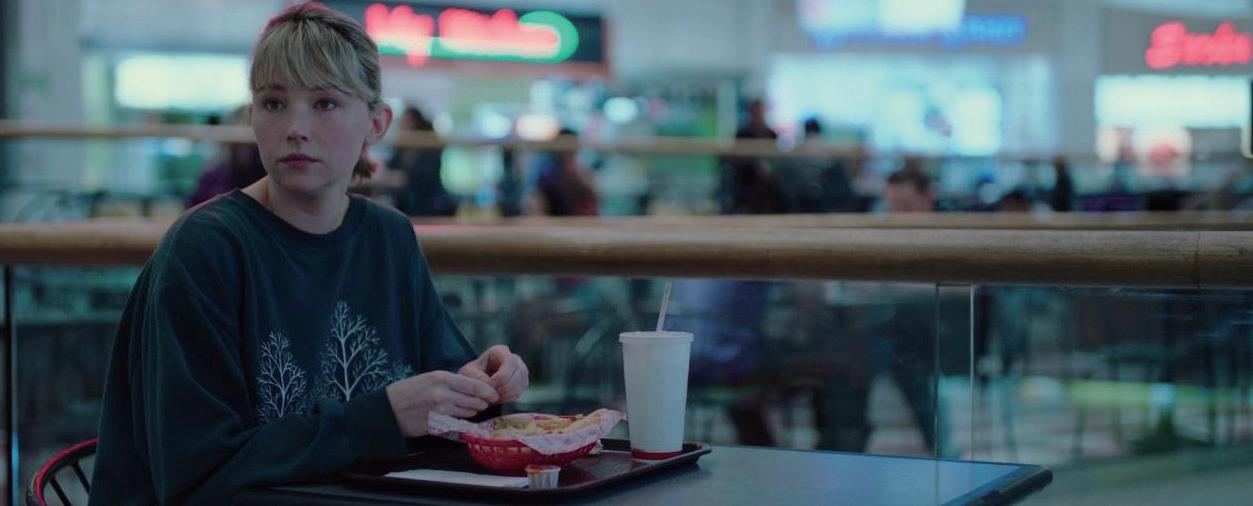
8 minute read
Tabletop Times with Oliver
With the edition theme being change, I couldn’t think of anything directly linked to tabletop games that would fill out an entire article by itself. So instead, I have a little collection of ideas all based around change that I thought I’d just try and touch on one at a time. Up first, a little nugget of wisdom that has saved my love of table top games more than once. If you are able to convince your group, it can be a great idea to switch up Dungeon Masters! There’s quite the list of reasons this is a great idea, but here are just a few. One, if your regular DM has played as a character as well as run the show, it can improve their ability to think like a character and keep things moving a hundred fold!
Secondly, give some other players a go to take the helm and tell a story. Chances are you’ll be pleasantly surprised. and players who have DM-ed usually have a better respect of the DM and the game rules. Lastly… a little break in a main campaign to tell a little side story can make excitement levels go through the roof! Honestly, I think it’s done our group wonders. Another idea that’s close to this is that, if you can, switch up the game you’re playing! so many other games have great ideas and allow you to play with other settings that can make tabletop gaming super refreshing. as well as this, you’ll come across so many ideas you can port straight across into Dungeons and Dragons as well. I’ve already mentioned Stars Without Numbers before here, and like I said there, its free and a great place to start.
It’s also worth noting that dungeons and dragons has had several different editions itself as well, with the current edition we play called 5th edition. I know some people still enjoy 4th edition and even 3.5 gets talked about still. The same goes for plenty of other systems, with pathfinder having several, and the Warhammer role playing games having several different games and updates. It’s definitely worth checking out other versions, there are some ideas in the older dnd that are actually pretty cool and can add some tension. 3.5 in particular was a little more complicated, but had a system for leveling beyond level 20, and a different system to determine skills. It’s a dnd version I’ve always wanted to try.
I think change is a good thing in almost all walks of life, and time and time again, when it concerns tabletop games, I’ve never had change teach me nothing and ruin the games. Usually, even if the new game were trying is a little complicated, or the new DM doesn’t quite get it, the lessons we learn through the process teach me how to better run a game, and in the long run, how to have a lot more fun!
Lavender Oil and Sticker Charts
“Wait! What?”
Margot Albrecht’s Column
Margot is a mature aged creative writing honours student.
I’m a mother of an autistic young woman, however, until two years ago I could not have legitimately made that statement. Nor could my daughter have been able to legitimately identify as autistic. My family experienced years (sixteen to be precise) of both armchair and actual experts pigeonholing my daughter under the one-size-fits-all label of ‘generalised anxiety’.
Back in 2004, as a first-time mother, I had a persistent, unfiltered drip-feed from family, friends, neighbours, supermarket check-out operators, hairdressers, everyman, and their dog, who all offered opinions and advice on pregnancy and parenting; on what I was doing wrong and why my new baby girl would not stop crying and would not sleep. I was spoiling her by holding her too much. I needed to be tough. I needed to let her cry. Babies like going for walks in a pram (my baby didn’t). Babies like being bathed (my baby didn’t). Babies like car rides (my baby didn’t). My baby screamed through everything that ‘normal’ babies liked.
And so it went on.
At kindy I was informed my daughter had ‘severe separation anxiety’ and that I should make our home so uncomfortable and unwelcoming that she would want to leave it to come to kindy. I was advised my daughter should see a child psychologist. We dutifully booked her in with the recommended psychologist, only to be told that our daughter was ‘spoilt and used to getting her own way’.
And so it went on.
At primary school we were advised, once more, to somehow deconstruct our home from the safe haven that I had intentionally created for my little family to something less inviting, the theory being (again) that my daughter would be glad to be away from it. At the behest of educators and mental health professionals, we devised sticker chart reward systems; going to school was ‘good’ and warranted a sticker. Not going to school was ‘bad’ and a sticker was taken away. We invested in aromatherapy diffusers and organic essential lavender oil in little roll-on bottles, which we applied to her pulse points; behind her ears, wrists, temples and bottom of her feet. Her school refusal became so chronic, that the front desk receptionist warned me the school might have to involve the police. ‘Good,’ I said. ‘Call the police. Then we might actually get some help.’
And so it went on.
I knew, in my gut, that whatever was going on with my daughter, it was bigger than lavender oil and sticker charts. But neither she, nor I, nor her father could put a name to it.
And so it went on… until October 2019. A close friend of mine, who has known my daughter since she was six months old, sent me a text message. It read: Have you considered that your daughter might be autistic? It presents differently in girls.
Wait! What?
Autistic? I was almost offended. My knowledge of autism was limited to the Hollywood ‘genius savant’ portrayed by Dustin Hoffman in the 1996 movie Rain Man, and the little boy at my kids’ school who had chairthrowing meltdowns in the classroom. My daughter didn’t throw chairs. But she did have meltdowns once she was within the confines of her overly comfortable, safe-haven home.
Then, two days after I received that well-meaning but disconcerting message from my friend, we were in
Melbourne for PAX (the gaming Force is strong in our family). We were at a bustling, noisy Thai restaurant and my daughter was shutting down, getting teary and panicked. Wordlessly, I opened the message from my friend and covertly passed it under the table to my husband. I studied him as he read the message, waiting for a dismissive eye-roll and for him to sling my phone back to me with a reassuring ‘of course our daughter isn’t autistic’ look. But he didn’t. His expression was serious as he read my friend’s message. Then his eyes met mine. And he nodded.
In that moment, my perception of our little world changed. Permanently.
I gingerly offered my daughter my ear buds to distract her from the ambient noise of the busy restaurant. She accepted, put them in and then sat, quietly absorbed in her Switch, until it was time to leave.
Once we returned to Adelaide, I began trying the word ‘autism’ out for size. I floated it past educators, health professionals, family, and friends. Their response was unified: my daughter couldn’t possibly be autistic. She can smile. She makes eye contact. She has a sense of humour. She has empathy. She doesn’t look autistic.
And so it went on.
She lasted for two weeks at High School. We then home schooled her. She was withdrawing into herself. My beautiful, vibrant, creative, loving, funny, caring daughter was becoming a shadow. Paler. Thinner. I feared she might disappear altogether. Cease to exist. I was bewildered and terrified. Still, she could not put into words how she felt. But, thanks to a character in a JRPG and a WordPress blog post, everything was about to change.
At the end of 2020, my daughter mentioned how much she identifies with Futaba, a character from Persona 5.

My own reseach led me to a blog by Sam Rowett, a UK based professional Game & Narrative Designer, which was written in a way that helped me to understand.
I read it. And re-read it. Finally, finally, my daughter had found a way to verbalise her experience. I sent a link of Sam Rowett’s article to her psychologist and by May of 2021 my daughter was finally, finally officially diagnosed with ASD (Autism Spectrum Disorder). On receiving her diagnosis, my daughter burst into tears of relief and joy and thanked the medical professional. I cried too but my relief was also tinged with fear. How would our life look now? What will the future hold for my daughter? One close family member, on hearing about my daughter’s autism diagnosis, blurted, ‘Oh, that’s awful. They can’t cure that, can they?’ This isn’t one of those ‘just add a diagnosis and everyone lived happily ever after’ stories. My daughter faces ongoing daily challenges as a neurodivergent young woman navigating a neurotypical society. As soon as my daughter was legally old enough to leave school, we pulled her out. She now devotes her time to her passions: digital art, gaming and streaming. She has taught herself to play the drums, electric and bass guitar. She is currently attending weekly singing lessons. She has a small band of loyal online friends but her old school friends have, naturally, left her behind as they forge ahead with boyfriends, partying, driving, gap years and Uni. While my daughter is yet to venture too far into the ‘real’ world beyond her comfort zone of home and games, it remains my hope that one day, the rest of the world will be lucky enough to know my daughter as I do: vibrant, funny, caring, creative, courageous, Autistic.
I’d love to hear about your own Wait! What? moments, where your perception of self, or others, has been altered by finally receiving a long-awaited diagnosis.

Dir. by Carlo Mirabella-Davis 2019

*SPOILERS*
TW: Self-harming, Sexual Assault, Mental Health/Disorder, Toxic Relationships, and Abortion.
Swallow (2019) is written and directed by Carlo Mirabella-Davis. The film focuses on a pregnant woman named Hunter (Haley Bennett) with Pica Disorder trapped with a heartless abusive husband (Austin Stowell). The film is a straight up cinematically beautiful film with Katelin Arizmendi behind the lens; who is now well-known for Dune (2021). In my opinion if you like Gone Girl (2014), you would like this. The camera was an ARRI amira with prime lenses, an aspect ratio of which is 2.39:1 - (which is my personal favourite Aspect Ratio).
Colour plays a striking role in this film not just by cinematography but also in the background of the story and character’s minds. The colours and visuals show you what’s going on especially in the heads of characters, this film is a perfect example of how a skilled filmmaker can use colour. It’s subtle, yet impressive and vital. Colour consistency fills the scenes, and bright colours want to pop out of the screen and it contrasts nicely from scene to scene. The film begins with simple and delightful textures, which develop into those simple textures disappearing. As Hunter enters a society without the Ikea minimalism and the textures change from grey and earth tones to mixed colours and graphic tees.










